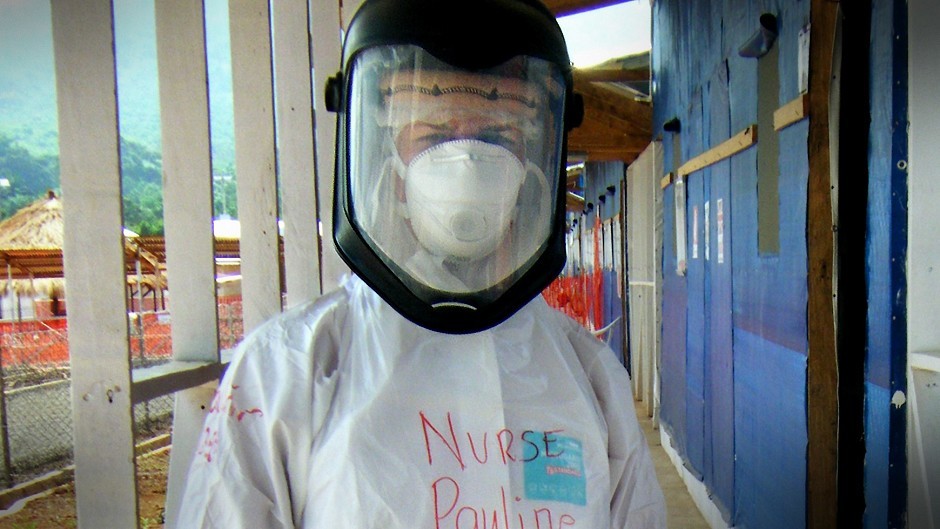The Scottish nurse who contracted Ebola in Sierra Leone has agreed to be treated with an experimental anti-viral drug and blood from a survivor of the virus, her doctor has said.
Pauline Cafferkey, a public health nurse at Blantyre Health Centre in South Lanarkshire, is receiving specialist treatment via a quarantine tent at the Royal Free Hospital in north London after initially flying home from Heathrow to Glasgow.
Dr Michael Jacobs said Ms Cafferkey was being treated with convalescent plasma taken from the blood of a recovered patient and an experimental anti-viral drug which is “not proven to work.”
But he revealed the hospital was unable to obtain ZMapp, the drug used to treat fellow British volunteer nurse William Pooley, who recovered, because “there is none in the world at the moment”.
Describing the patient’s condition, Dr Jacobs said: “She is sitting up and talking. She is able to read. She’s been eating a bit, drinking and she’s been in communication with her family, which has been really nice.
“She’s as well as we can hope for at this stage of the illness.
“She’s had the treatment, it’s gone very smoothly, no side-effects at all.
“I’m sure this isn’t how she intended to spend New Year’s Eve.”
Dr Jacobs said the next few days were “critical” but Ms Cafferkey was in an early phase of the disease which gave the hospital the “best opportunity to give her treatment”.
“At the moment, we don’t know what the best treatment strategies are,” he said. “That’s why we’re calling them experimental treatments.
“As we’ve explained to Pauline, we can’t be as confident as we would like. There’s obviously very good reason to believe it’s going to help her, otherwise we wouldn’t be using it at all, but we simply don’t have enough information to know that’s the case.”
Dr Jacobs said Ms Cafferkey’s family were unable to touch her but can see her and speak to her through an internal communication system.
“The family speak to her through an intercom system,” he said. “They can see each other clearly. They are talking face to face but without direct contact between the two.”
Dr Jacobs said there were several stocks of plasma around Europe which would be considered in the treatment of Ms Cafferkey.
“When the need arises, the various experts around Europe convene a conference, and decide the most appropriate plasma for the patient,” he said. “It’s plasma from a patient who has survived from Ebola and is treated in Europe.”
Mrs Cafferkey, from Glasgow, was part of a 30-strong team of medical volunteers deployed to Africa by the UK Government last month and had been working with Save the Children at the Ebola Treatment Centre in Kerry Town, Sierra Leone.
She was initially placed in isolation at a Glasgow hospital early on Monday after feeling feverish, before being transferred south on an RAF C-130 Hercules plane.
The healthcare worker had flown from Sierra Leone via Morocco to Heathrow, where she was considered a high risk because of the nature of her work but showed no symptoms during screening and a temperature check.
However, while waiting for a connecting flight to Glasgow she raised fears about her temperature and was tested a further six times in the space of 30 minutes.
Despite her concerns, she was given the all-clear and flew on to Scotland where, after taking a taxi home, she later developed a fever and raised the alarm.
The Government’s chief medical officer, Dame Sally Davies, said questions have been raised about the airport screening procedure for Ebola but insisted that the nurse’s temperature was checked.
She told ITV’s Good Morning Britain: “We regularly keep under review what we are doing because this is a new process.
“Clearly queuing and things like that are unacceptable and we will review.
“But we will let people who are well travel because they will not infect the public.”
She added: “(Mrs Cafferkey) was well. She had no symptoms. Her temperature was within the acceptable range.
“She would not be transmitting the virus, therefore she was cleared as fit to fly.”
A Department of Health spokesman said: “We have been clear – this person was tested as part of the screening process at Heathrow and, as with all health workers, she was advised to contact PHE (Public Health England) if she had any concerns. She did this, while still at Heathrow, and went through a further six temperature checks.
“Her temperature was in acceptable ranges and she was cleared for onward travel, with the advice that if she did start to feel unwell, she should contact health authorities.
“After this person got home, she alerted health authorities that she was experiencing symptoms and was admitted to hospital for tests.
“Naturally, we will be reviewing what happened and the screening protocols, and if anything needs to be changed it will be.”
A spokeswoman for the Department for International Development (DFID) said Mrs Cafferkey travelled to Heathrow on the same flight as the other 29 medical volunteers she was deployed with.
Two other groups were deployed earlier this month and are still in Africa. A team of 25 went out on December 6 and a dozen medics flew there on December 21.
The DFID spokeswoman said: “We expect further volunteers to be trained and deployed in the coming weeks.”
